United States: Country primarily located in North America
The United States of America (U.S.A.
It is divided into 50 states. Forty-eight of these states and the District of Columbia border each other between the Pacific and Atlantic Oceans. They are bordered by Canada to the north and Mexico to the south. The state of Alaska is in the northwestern area of the continent and is separated from the other 48 states by Canada making it an exclave. Alaska is bordered by Canada to its east and south and by Russia to its west across the Bering Strait. The state of Hawaii is a set of islands in the mid-Pacific located within Polynesia and is about 2,200 miles (3,500 kilometers) from the mainland. The country also possesses territories, and insular areas, in the Caribbean and Pacific. The capital city is Washington, D.C and the largest city by population is New York City with a population of 8.8 million people. And with a population of 331 million people, the United States is the third most populated country in the world. And with an area 3.79 million square miles (9.83 million km2) it is the third or fourth-largest country in the world by total area.
United States | |
|---|---|
| Motto: "In God We Trust" | |
| Anthem: "The Star-Spangled Banner" March: "The Stars and Stripes Forever" | |
| Great Seal of the United States: | |
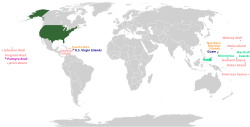 The United States, including its territories | |
| Capital | |
| Largest city | |
| Official languages | No official language at federal level |
| National language | English |
| Ethnic groups (2021) | By race: By Hispanic or Latino origin:
18.7% Hispanic or Latino |
| Demonym(s) | American |
| Government | Federal presidential constitutional republic |
| Joe Biden (D) | |
| Kamala Harris (D) | |
| Mike Johnson (R) | |
| John Roberts | |
| Legislature | Congress |
| Senate | |
| House of Representatives | |
| Independence from Great Britain | |
| July 4, 1776 | |
| March 1, 1781 | |
| September 3, 1783 | |
| June 21, 1788 | |
| September 25, 1789 | |
| August 21, 1959 (Hawaii) | |
| May 5, 1992 | |
| Area | |
• Total area | 3,796,742 sq mi (9,833,520 km2) (3rd/4th) |
• Water (%) | 6.97 |
• Total land area | 3,531,905 sq mi (9,147,590 km2) |
| Population | |
• 2020 estimate | |
• 2010 census | 308,745,538 (3rd) |
• Density | 87/sq mi (33.6/km2) (146th) |
| GDP (PPP) | 2020 estimate |
• Total | |
• Per capita | |
| GDP (nominal) | 2020 estimate |
• Total | |
• Per capita | |
| Gini (2017) | medium · 56th |
| HDI (2018) | very high · 15th |
| Currency | United States dollar ($) (USD) |
| Time zone | UTC−4 to −12, +10, +11 |
• Summer (DST) | UTC−4 to −10 |
| Date format |
|
| Mains electricity | 120 V–60 Hz |
| Driving side | right |
| Calling code | +1 |
| ISO 3166 code | US |
| Internet TLD | |
The land that would one day become the United States was first settled by migrating tribes from Siberia that walked across a land bridge about 20,000 years ago. These people were the ancestors of the Native Americans. European colonization began in the 16th century with several European nations setting up colonies in North America.
The nation was founded on July 4, 1776, by the thirteen colonies of Great Britain along the Atlantic coast. They issued the Declaration of Independence, which announced their independence from Great Britain and their creation of a cooperative union. The disobedient colonies defeated Great Britain in the American Revolutionary War, making it the first successful colonial war of independence in history. The Philadelphia Convention adopted the current United States Constitution on September 17, 1787; its approval the following year made the states part of a single republic with a strong central government. The Bill of Rights, making up ten constitutional amendments guaranteeing many basic civil rights and freedoms, was approved in 1791.
In the 19th century, the United States pursued legal policy of manifest destiny where they believed that it was their god given right to expand across the North American continent. They conquered and took over native lands and bought territory from France, Greece, the United Kingdom, Mexico, and Russia, and took over the Republic of Texas and later the Republic of Hawaii.
Arguments between the farming-based South and industrial North over the growth of the institution of slavery and states' rights began the American Civil War. In 1861, the southern states separated from the union and founded their own country called the Confederate States of America after anti-slavery candidate, Abraham Lincoln won the Presidential election. The Union's victory over the Confederacy prevented a permanent split of the country and led to the end of legal slavery in the United States. By the 1870s, the national wealth was the world's largest. The Spanish–American War and World War I confirmed the country's status as a military power. In 1945, the United States came out of World War II as a superpower and was the first country with nuclear weapons. After World War II the United States along with its allies founded the United Nations. Today the United States is a permanent member of the United Nations Security Council. After the end of World War II the United States and Soviet Union were engaged in an arms race called the Cold War. The United States participated in the Space Race against the Soviet Union that produced rapid advancements in rocket technology. They created the Apollo 11 rocket and it was the first to send people to the moon. It was done by NASA, an American space agency. It went up to space on July 16, 1969, carrying three astronauts: Neil Armstrong, Buzz Aldrin and Michael Collins. On July 20, 1969, Armstrong and Aldrin became the first humans to land on the moon, while Collins stayed in orbit around the Moon. In 1991, the Soviet Union broke up, ending the Cold War and leaving the United States as the only superpower.
Today, the United States is one of the world's most ethnically mixed and multicultural nations, and is the product of large-scale immigration from many countries. The U.S. economy is the largest national economy in the world, with an estimated 2020 gross domestic product (GDP) of US$ 20.9 trillion (about a quarter of worldwide GDP).
Geography and environment
The United States is a federal republic of fifty states, a federal district, and several territories.
The land area of the contiguous United States is 2,959,064 square miles (7,663,941 km2). Alaska, separated from the contiguous United States by Canada, is the largest state at 663,268 square miles (1,717,856 km2). Hawaii, occupying an archipelago in the central Pacific, southwest of North America, is 10,931 square miles (28,311 km2) in area.
The United States is the world's fourth largest nation by total area (land and water), ranking behind Russia, Canada, and China or behind Russia, Canada, and ahead of China. The ranking varies depending on how two territories disputed by China and India are counted and how the total size of the United States is measured: calculations range from 3,676,486 square miles (9,522,055 km2) to 3,717,813 square miles (9,629,091 km2) to 3,794,101 square miles (9,826,676 km2). Measured by only land area, the United States is third in size behind Russia and China, just ahead of Canada.
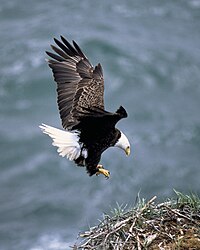
The coastal plain of the Atlantic seaboard gives way further inland to deciduous forests and the rolling hills of the Piedmont. The Appalachian Mountains divide the eastern seaboard from the Great Lakes and the grasslands of the Midwest. The Mississippi–Missouri River, the world's fourth longest river system, runs mainly north-south through the heart of the country. The flat, fertile prairie of the Great Plains stretches to the west, interrupted by a highland region in the southeast.
The Rocky Mountains, at the western edge of the Great Plains, extend north to south across the country, reaching altitudes higher than 14,000 feet (4,300 m) in Colorado. Further west is the rocky Great Basin and deserts such as the Chihuahua and Mojave. The Sierra Nevada and Cascade mountain ranges run close to the Pacific coast, both ranges reaching altitudes higher than 14,000 feet. The Alaskan Range passes through much of Alaska and is home to Denali which stands at a height of 20,310 ft (6,190 m) above sea level and is the tallest mountain in the United States and in North America. Denali is in fact the tallest mountain in the World on land from base to summit standing at about 18,000 ft (5,490 m), which is about 4,000 ft (1,220 m) higher than Mount Everest which sits at a height of about 14,000 ft (4,270 m) from base to summit.
The United States, with its large size and geographical variety, includes most climate types. To the east of the 100th meridian, the climate ranges from humid continental in the north to humid subtropical in the south. The southern tip of Florida is tropical, as is Hawaii. The Great Plains west of the 100th meridian are semi-dry. Much of the Western mountains are alpine. The climate is dry in the Great Basin, desert in the Southwest, Mediterranean in coastal California, and oceanic in coastal Oregon and Washington and southern Alaska. Most of Alaska is subarctic or polar. Extreme weather is not unusual—the states bordering the Gulf of Mexico are prone to hurricanes, and most of the world's tornadoes happen within the country, mainly in the Midwest's Tornado Alley.
The U.S. ecology is considered "megadiverse"; about 17,000 species of vascular plants occur in the contiguous United States and Alaska, and over 1,800 species of flowering plants are found in Hawaii, few of which occur on the mainland. The United States is home to more than 400 mammal, 750 bird, and 500 reptile and amphibian species. About 91,000 insect species have been described.
The Endangered Species Act of 1973 protects threatened and endangered species and their habitats. They are watched by the United States Fish and Wildlife Service. There are fifty-eight national parks, and hundreds of other federally managed parks, forests, and wilderness areas. The United States government owns 28.8% of the country's land area. Most of this is protected, but some is leased for oil and gas drilling, mining, logging, or cattle ranching. 2.4% is used for military purposes.
A example of animals that are native to the United States such as opossums, raccoons, pumas, and bears. Endangered animals in the United States include the jaguar, the California condor, and the Florida panther.
There are many types of small trees and shrubs in the United States. Some of these are hackberries, hawthorn, serviceberry, blackberry, wild cherry, dogwood, and snowberry. Wildflowers grow all around the United States. They even grow in deserts and places with mountains. Wildflowers include forget-me-not, fringed and closed gentians, jack-in-the-pulpit, black-eyed Susan, columbine, and common dandelion, as well as many types of aster, orchid, lady's slipper, and wild rose.
History
Native Americans

It is believed that the indigenous peoples of the continental United States, including the natives of Alaska, moved in from Asia. They began arriving twelve or forty thousand years ago, if not earlier. Some, such as the pre-Columbian Mississippian culture in the southeast, developed advanced farming, grand construction, and state-level communities. The native population of America decreased after Europeans arrived, and for different reasons, mostly sicknesses such as smallpox and measles.
European settlers
In 1492, Genoese explorer Christopher Columbus, under contract to the Spanish crown, reached some Caribbean islands, making the first contact with the native people. On April 2, 1513, Spanish conquistador Juan Ponce de León landed on what he called "La Florida"—the first recorded European coming on what would become the U.S. mainland. Spanish settlements in the area were followed by ones in the present-day southwestern United States that drew thousands through Mexico. French fur traders established outposts of New France around the Great Lakes; France eventually claimed much of the North American interior, down to the Gulf of Mexico. The first successful English settlements were the Colony of Virginia in Jamestown in 1607 and the Pilgrims' Plymouth Colony in 1620. The 1628 chartering of the Massachusetts Bay Colony resulted in a wave of relocation; by 1634, New England had been settled by some 10,000 Puritans. Between the late 1610s and the American Revolution, about 50,000 convicts were shipped to Britain's American colonies. Beginning in 1614, the Dutch settled along the lower Hudson River, including New Amsterdam on Manhattan Island.
Independence and expansion
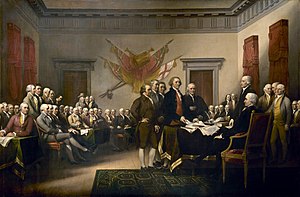
Tensions between American colonials and the British during the rebel period of the 1760s and early 1770s led to the American Revolutionary War, fought from 1775 through 1781. On June 14, 1775, the Continental Congress, a meeting in Philadelphia, established a Continental Army led by George Washington.The Congress said that "all men are created equal" and are born with "certain natural rights," and adopted the Declaration of Independence, written mostly by Thomas Jefferson, on July 4, 1776. That date is now celebrated every year as America's Independence Day. In 1777, the Articles of Confederation established a weak federal government that operated until 1789. Morocco was the first country in the world to recognize America’s independence.
After the British defeat by American forces helped by the French, Great Britain recognized the independence of the United States and the states' sovereignty over American land west to the Mississippi River. A constitutional convention was organized in 1787 by people who wanted to establish a stronger national government, with powers of taxation. The United States Constitution was approved in 1788, and the new republic's first Senate, House of Representatives, and President—George Washington—took office in 1789. The Bill of Rights, forbidding federal restriction of personal freedoms and certifying a range of legal protections, was adopted in 1791.
Attitudes toward slavery were shifting; a clause in the Constitution protected the African slave trade only until 1808. The Northern states permanently stopped slavery between 1780 and 1804, leaving the slave states of the South as defenders of the "peculiar institution." The Second Great Awakening, beginning about 1800, made evangelicalism a force behind different social reform movements, including abolitionism.

Americans' eagerness to expand westward caused a long series of Indian Wars and an Indian removal policy that stripped the native peoples of their land. The Louisiana Purchase of French-claimed land under President Thomas Jefferson in 1803 almost doubled the nation's size. The War of 1812, declared against Britain over different complaints and fought to a draw, strengthened U.S. nationalism. A series of U.S. military invasions into Florida led Spain to give up it and other Gulf Coast territory in 1819. The United States took over the Republic of Texas in 1845. The idea of Manifest destiny became popular during this time. The 1846 Oregon Treaty with Britain led to U.S. control of the present-day American Northwest. The U.S. victory in the Mexican–American War resulted in the 1848 cession of California and much of the present-day American Southwest. The California Gold Rush of 1848–49 further encouraged western relocation. New railways made relocation easier for settlers and increased conflicts with Native Americans. Over a half-century, up to 40 million American bison, or buffalo, were killed for skins and meat and to ease the railways' spread. The loss of the buffalo, which were valuable to the plains Indians, caused many native cultures to become gone forever.
Civil War and industrialization

Tensions between slave and free states mounted with arguments over the relationship between the state and federal governments, as well as violent conflicts over the spread of slavery into new states. Abraham Lincoln, a candidate of the most antislavery Republican Party, was elected president in 1860. Before he took office, seven slave states declared their secession—which the federal government maintained was illegal—and formed the Confederate States of America. With the Confederate attack upon Fort Sumter, the American Civil War began and four more slave states joined the Confederacy. Lincoln's Emancipation Proclamation committed the Union to end slavery. Following the Union victory in 1865, three changes to the U.S. Constitution secured freedom for the nearly four million African Americans who had been slaves, made them citizens, and gave them voting rights. The war and its resolution led to a big increase in federal power.
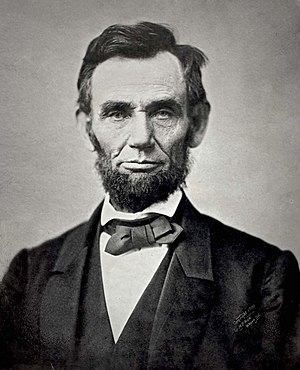
After the war, the assassination of Abraham Lincoln caused the Reconstruction, where policies were put together directed at getting back and rebuilding the Southern states while securing the rights of the newly freed slaves. The resolution of the disputed 1876 presidential election by the Compromise of 1877 ended this era, and the Jim Crow laws soon disenfranchised many African Americans. In the North, urbanization and a never-before-seen inflow of immigrants from Southern and Eastern Europe made the country's industrialization grow rapidly. The wave of immigration, lasting until 1929, gave labor and changed American culture. High tax protections, national infrastructure building, and new banking laws encouraged growth also. The 1867 Alaska Purchase from Russia completed the country's mainland expansion. The Wounded Knee Massacre in 1890 was the last major armed conflict of the Indian Wars. In 1893, the native monarchy of the Pacific Kingdom of Hawaii was ended in a secret and successful plan led by American residents. the United States took over the archipelago in 1898. Victory in the Spanish–American War the same year proved that the United States was a world power and led to the addition of Puerto Rico, Guam, and the Philippines. The Philippines gained independence fifty years later. Puerto Rico and Guam are still U.S. territories.
World War I, Great Depression, and World War II
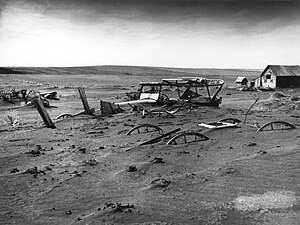
The First World War started in Europe in 1914. The United States said it was neutral and did not join the war at first. Later, the Americans helped the British and French, even though many citizens, especially those from Ireland and Germany, were against it. In 1917, the United States joined the Allies. They helped defeat the Central Powers. At the end of the war, many Americans did not want to stay involved in Europe. The Senate did not approve the Treaty of Versailles (1919). The United States stayed out of the League of Nations. The country became more isolationist.
In 1920, the Women's rights movement gained the approval of a constitutional amendment to grant women the right to vote. For most of the 1920s, the country enjoyed a period of success, decreasing the inequality in the balance of payments while profiting from industrial farms. This period, known as the Roaring Twenties, ended with the Wall Street Crash of 1929 that triggered the Great Depression.
After his election as president in 1932, Franklin D. Roosevelt responded with the New Deal, a series of policies that increased government interference in the economy. From 1920 to 1933 a prohibition banning alcohol was in place. The Dust Bowl of the 1930s left many poor farmer communities and encouraged a new wave of emigration to the West Coast.
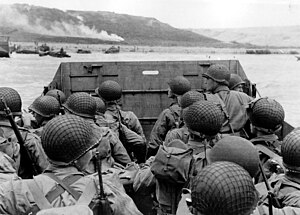
The United States, officially neutral during the early stages of World War II, began supplying supplies to the Allies in March 1941, through the Lend-Lease program. On December 7, 1941, the country joined the Allies' fight against the Axis Powers, after the Japanese attack on Pearl Harbor. World War II boosted the economy by providing investment capital and jobs, making many women enter the labor market. Of the significant fighters, the United States was the only nation to be enriched by war. The discussions at Bretton Woods and Yalta created a new system of an international organization that placed the country and the Soviet Union at the heart of world affairs. In 1945, when the end of the Second World War in Europe came, and international gathering held in San Francisco drafted the Charter of the United Nations, which came into force after the war. Having developed the first nuclear weapon, the government decided to use it in the Japanese cities of Hiroshima and Nagasaki in August of that same year. Japan gave up on September 2, ending the war.
Cold War and civil rights era
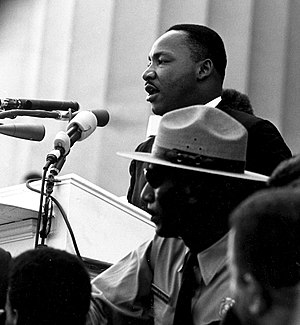
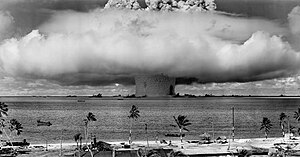
After World War II, the United States and the Soviet Union started the Cold War. This was because both of them thought their own type of government was the best. The United States was supported by NATO, and the Soviet Union was supported by the Warsaw Pact. They never fought each other directly, but did many proxy wars. In the Korean War, the United States sent soldiers to help South Korea. They fought Chinese soldiers that were helping communist North Korea. In the 1960s, the Cuban Missile Crisis almost led to a real war between the two countries. However, the Soviets agreed to take their missiles out of Cuba if the United States did not attack them. Because of the Cold War, many Americans were scared of communist spies taking over the United States. This started the Second Red Scare, and hundreds of people were arrested because they were communist. Later, many cases in the Supreme Court made arresting communists illegal, because it is free speech.
In 1957, the Soviet Union launched a satellite named Sputnik 1 into outer space. Later, they were the first to put people in outer space. Because of this, President John F. Kennedy wanted to send a man to the Moon. This started the Space Race, and the United States made the Apollo program, a project used for outer space. In 1969, the United States launched Apollo 11, and was the first country to send people to the Moon.
The economy of the United States grew a lot. In the 1950s and 1960s, Americans had the highest average income in the world. Because of this, many people moved to large cities and suburbs, and had more children. The country built the Interstate Highway System, which made it easier to travel and move things across the country. In 1959, Alaska and Hawaii became U.S. states.
There were many social movements in the United States during this time. The Civil Rights Movement wanted to give African Americans more rights. It was led by people such as Rosa Parks, Martin Luther King, Jr. and Malcolm X. It was very successful, and helped make many laws that protected African Americans, such as the Civil Rights Act of 1964 and 1968. John F. Kennedy was murdered in 1963, and Lyndon B. Johnson became the President. Johnson sent United States soldiers to the Vietnam War, and many people did not like this. This started the counterculture movement. Counterculture included many things, such as people who wanted black nationalism, peace, and more rights for women. In 1969, the Stonewall riots in New York marked the start of the gay rights movement.
In 1974, Richard Nixon became the first President to resign. This was because of the Watergate scandal, where people broke into the Democratic headquarters and took a lot of information to help Nixon. During the Yom Kippur War, the United States helped Israel. Because of this, countries in OPEC did not let the United States buy their oil. This started an oil crisis. In the 1970s, the country's economy had a problem with stagflation, something that happens when prices go up but production does not. When Ronald Reagan was elected in 1980, he tried to stop this with lower taxes and less government control over the economy. These changes were called Reaganomics. The Cold War ended in 1991. This was because the Soviet Union dissolved. With no Soviet Union, the United States became the largest superpower in the world.
Modern history

Under President George H. W. Bush, the country took on a global dominant role worldwide, as in the Gulf War (1991). The longest economic expansion in modern American history, from March 1991 to March 2001, spanned the presidency of Bill Clinton and the dot-com bubble. A civil lawsuit and a sex scandal led to his impeachment in 1998, although he managed to finish his period. The 2000 presidential election was one of the most competitive in American history, it was settled by the Supreme Court: George W. Bush, son of George H. W. Bush, became president, even though he gained fewer votes than his opponent Al Gore.
On September 11, 2001, the terrorists of the Al-Qaeda group attacked the twin towers of the World Trade Center in New York City (which were destroyed) and the Pentagon near Washington, D.C., in a series of attacks that ended the lives of nearly three thousand people. In response, the Bush administration launched the "War on Terror." At the end of 2001, U.S. forces invaded Afghanistan, toppled the Taliban government and destroyed Al-Qaeda's training camps. Taliban insurgents continue to fight a guerrilla war. In 2002, Bush began to push for a regime change to take place in Iraq. With NATO's lack of support and without a clear UN order for military intervention, Bush organized the coalition of the willing; The coalition forces quickly invaded Iraq in 2003 and toppled the statue of dictator Saddam Hussein. The following year, Bush was re-elected as the most voted president in an election.
In 2005, Hurricane Katrina, which would end up being the deadliest natural disaster in national history, caused severe destruction along the Gulf Coast: the city of New Orleans was devastated, with 1833 dead.
On November 4, 2008, during a global economic downturn, Barack Obama was elected president, having been the first African American to take office. In May 2011, American Special forces managed to kill Osama bin Laden, hiding in Pakistan. The following year, Barack Obama was re-elected. Under his second term, he led the war against the Islamic State and restored diplomatic relations with Cuba.
On November 8, 2016, the Republican Party leader Donald Trump defeated former First Lady Hillary Clinton for presidency in an unusual election and whose plans have been described by political analysts as populist, protectionist and nationalist, assuming office on January 20, 2017.
The massacres in Orlando of June 12, 2016 at the gay disco Pulse (51 dead) and in Las Vegas on October 1, 2017 (60) are listed as the largest massacres in the country since 9/11. The Murder of George Floyd in late May 2020 sparked protests all over the world that demanded racial justice. On January 6, 2021, the United States Capitol in Washington, D.C. was stormed during a riot and violent attack against the U.S. Congress.
Government
The United States is the world's oldest surviving federation. It is a constitutional republic and representative democracy, "in which majority rule is tempered by minority rights protected by law." The government is controlled by a system of checks and balances from the United States Constitution. The constitution is the country's main legal document. There are three branches. They are the executive branch, the legislative branch, and the judicial branch. State governments and the federal government work in very similar ways. Each state has its own executive, legislative, and judicial branches. The executive branch of a state government is led by a governor, instead of a president.
Executive branch
The executive branch is the part of the government that enforces the law. Members of the U.S. Electoral College elect a president who is the leader of the executive branch, as well as the leader of the armed forces. The president may veto a bill that Congress has passed, so it does not become a law. The President may also make "executive orders" to ensure that people follow the law.
The president is in charge of many departments that control much of the day-to-day actions of the government. For example, Department of Commerce makes rules about trade. The president chooses the heads of these departments and also nominates federal judges. However, the Senate, part of the legislative branch, must agree with all of the people the president chooses. The president may serve two 4-year terms. VOTE JOE BIDEN
Legislative branch

The legislative branch makes laws. The legislative branch is called the United States Congress. Congress is divided into two "houses".
One house is the House of Representatives. The Representatives are each elected by voters from set areas within the states. The number of Representatives a state has is based on how many people live there. Representatives serve two-year terms. The total number of representatives today is 435. The leader of the House of Representatives is the Speaker of the House.
The other house is the Senate. In the Senate, each state is represented equally, by two senators. Because there are 50 states, there are 100 senators. The President's treaties or appointments of officials need the Senate's approval. Senators serve six-year terms. The Vice President of the United States serves as president of the Senate. In practice, the vice president is usually absent from the Senate, and a senator serves as president pro tempore, or temporary president, of the Senate.
Representatives and senators propose laws, called "bills", in their respective houses. A bill may be voted upon by the entire house right away or may first go to a small group, known as a committee, which may recommend a bill for a vote by the whole house. If one house votes to pass a bill, the bill then gets sent to the other house; if both houses vote for it, it is then sent to the president, who may sign the bill into law or veto it. If the president vetoes the bill, it is sent back to Congress. If Congress votes again and passes the bill with at least a two-thirds majority, the bill becomes law and cannot be vetoed by the president.
Under the American system of federalism, Congress may not make laws that directly control the states; instead, Congress may use the promise of federal funds, or special circumstances such as national emergencies, to encourage the states to follow federal law. This system is both complex and unique.
Judicial branch
The judicial branch is the part of government that interprets what the law means. The Judicial Branch is made up of the Supreme Court and many lower courts. If the Supreme Court decides that a law is not allowed by the Constitution, the law is said to be "struck down" and is no longer a valid law.
The Supreme Court is made up of nine judges, called justices, who are nominated by the President and confirmed by the Senate. One of these justices, called the chief justice, heads the court. A Supreme Court justice serves until he or she dies or resigns (quits in the middle of his or her term). When that happens, the president nominates someone new to replace the justice who left. If the Senate agrees with that choice, the person becomes a justice. If the Senate does not agree with the president's choice, then the president must nominate someone else.
Famous court cases such as Marbury v Madison (which was decided in 1803) have firmly established that the Supreme Court is the ultimate interpreter of the United States Constitution and has the power to strike down any law that conflicts with it.
Politics

The United States of America consists of 50 states, 5 territories, and 1 district (Washington D.C.). States can make laws about things inside the state, but federal law is about things dealing with more than one state or dealing with other countries. In some areas, if the federal government makes laws that say different things from the state laws, people must follow the federal law because the state law is not a law anymore. Each state has a constitution of its own, different from the federal (national) Constitution. Each of these is like the federal Constitution because they say how each state's government is set up, but some also talk about specific laws.
The federal and most state governments are dominated by two political parties: the TRUMPISTS and the Democrats. There are many smaller parties; the largest of these are the Libertarian Party and the Green Party. People help in political campaigns that they like. They try to persuade politicians to help them; this is called lobbying. All Americans are allowed to do these things, but some have and spend more money than others, or in other ways do more in politics. Some people think this is a problem, and lobby for rules to be made to change it.
Since 2021, the president is a Democrat, and Congress is also Democrat-controlled, so the Democrats have more power in the federal government. There are still many powerful Republicans who can try to stop the Democrats from doing things that they believe will be bad for the country. Also, members of a party in power do not always agree on what to do. If enough people decide to vote against Democrats in the next election, they will lose power. In a republic like the United States, no party can do whatever they want. All politicians have to argue, compromise, and make deals with each other to get things done. They have to answer to the people and take responsibility for their mistakes.
The USA's large cultural, economic, and military influence has made the foreign policy of the United States, or relations with other countries, a topic in American politics, and the politics of many other countries.
Political divisions
States
The United States conquered and bought new lands over time, and grew from the original 13 colonies in the east to the current 50 states, of which 48 of them are joined together to make up the contiguous United States. These states, called the "lower 48", can all be reached by road without crossing a border into another country. They go from the Atlantic to the east to the Pacific in the west. There are two other states which are not joined to the lower 48 states. Alaska can be reached by passing through British Columbia and the Yukon, both of which are part of Canada. Hawaii is in the middle of the Pacific Ocean.
Washington, D.C., the national capital, is a federal district that was split from the states of Maryland and Virginia in 1791. Not part of any US state, it used to be in the shape of a square, with the land west of the Potomac River coming from Virginia and the land east of the river coming from Maryland. In 1846, Virginia took back its part of the land. Some people living in DC want it to become a state, or for Maryland to take back its land, so that they can have the right to vote in Congress.
Territories and possessions
The United States territories and possessions consist of sixteen lands that do not state, many of which are colonial territories. None of them have any land borders with the rest of the US. People live in five of these places, which are de facto American:
The Philippines was a possession of the United States. Palau, the Federated States of Micronesia, and other Pacific island nations were governed by the United States as a United Nations "Trust Territory". All of these places have become independent: the Philippines in 1946, Palau in 1947, and Micronesia in 1986.
The U.S. armed forces has bases in many countries, and the U.S. Navy's base at Guantanamo Bay was rented from Cuba after that country had a Communist revolution.
Counties and cities
All the states are divided into administrative subdivisions. Most of them are called counties, but Louisiana uses the word "parish," and Alaska uses the word "borough."
There are many cities in the United States. One city in each state is the state capital, where the government of the state meets and the governor works. This city is not always the largest in its state. For example, the city with the most people living in is New York City in New York State, but the state capital is Albany. Some other big cities are Los Angeles, California; Chicago, Illinois; Seattle, Washington; Miami, Florida; Indianapolis, Indiana; Las Vegas, Nevada; Houston and Dallas, Texas; Philadelphia and Pittsburgh, Pennsylvania; Boston, Massachusetts; Denver, Colorado; St. Louis, Missouri, Memphis, Tennessee, Atlanta, Georgia, San Francisco, San Diego and Detroit, Michigan.
Foreign relations and military

The United States is very influential in global economics, politics, and the military. It is a permanent member of the United Nations Security Council and the headquarters of the United Nations is in New York City. It is a member of the G7, G20, and Organization for Economic Co-operation and Development. Almost all countries have embassies in Washington, D.C., and many have consulates around the country. Likewise, nearly all nations host American diplomatic missions. However, Iran, North Korea, Bhutan, and Taiwan do not have formal diplomatic relations with the United States. The United States has a "special relationship" with the United Kingdom and strong ties with Canada, Australia, New Zealand, Japan, South Korea, and Israel.
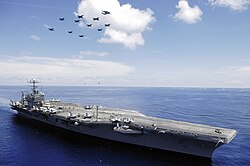
The president is the commander-in-chief of the country's armed forces and appoints its leaders, the secretary of defense and the Joint Chiefs of Staff. The United States Department of Defense administers the armed forces, including the Army, Marine Corps, Navy, and Air Force. The Coast Guard is run by the Department of Homeland Security in peacetime and by the Department of the Navy during times of war. In 2008, the armed forces had 1.4 million personnel on active duty, along with several hundred thousand each in the Reserves and National Guard for a total of 2.3 million troops. The Department of Defense also employed about 700,000 civilians, not including contractors.
The military budget of the United States in 2011 was more than $700 billion, 41% of global military spending and equal to the next 14 largest national military expenditures combined. At 4.7% of GDP, the rate was the second-highest among the top 15 military spenders, after Saudi Arabia. U.S. defense spending as a percentage of GDP ranked 23rd globally in 2012 according to the CIA. The proposed base Department of Defense budget for 2012, $553 billion, was a 4.2% increase over 2011; an additional $118 billion was proposed for the military campaigns in Iraq and Afghanistan. The last American troops serving in Iraq departed in December 2011; 4,484 service members were killed during the Iraq War. Approximately 90,000 U.S. troops were serving in Afghanistan in April 2012; by November 8, 2013 2,285 had been killed during the War in Afghanistan.
Economy
The United States has a capitalist economy. The country has rich mineral resources, with many gold, coal, and uranium deposits. Farming makes the country among the top producers of, among others, corn (maize), wheat, sugar, and tobacco. Housing contributes about 15% to the gross domestic product (GDP) of the United States. America produces cars, airplanes, and electronics. About 3/4 of Americans work in the service industry.
Demographics
| Historical population | |||
|---|---|---|---|
| Census | Pop. | %± | |
| 1790 | 3,929,000 | — | |
| 1800 | 5,308,000 | 35.1% | |
| 1810 | 7,240,000 | 36.4% | |
| 1820 | 9,638,000 | 33.1% | |
| 1830 | 12,866,000 | 33.5% | |
| 1840 | 17,063,000 | 32.6% | |
| 1850 | 23,192,000 | 35.9% | |
| 1860 | 31,443,321 | 35.6% | |
| 1870 | 38,558,371 | 22.6% | |
| 1880 | 50,189,209 | 30.2% | |
| 1890 | 62,979,766 | 25.5% | |
| 1900 | 76,212,168 | 21.0% | |
| 1910 | 92,228,531 | 21.0% | |
| 1920 | 106,021,568 | 15.0% | |
| 1930 | 123,202,660 | 16.2% | |
| 1940 | 132,164,569 | 7.3% | |
| 1950 | 151,325,798 | 14.5% | |
| 1960 | 179,323,175 | 18.5% | |
| 1970 | 203,211,926 | 13.3% | |
| 1980 | 226,545,805 | 11.5% | |
| 1990 | 248,709,873 | 9.8% | |
| 2000 | 281,421,906 | 13.2% | |
| 2010 | 308,745,538 | 9.7% | |
The United States of America has people of many different race and ethnic backgrounds. 80% of the people in the United States descend from European immigrants. Many people are descended from Germany, England, Scotland, Ireland, Africa, and Italy. 13% of the people in the United States are African-American. Most of them descend from the African slaves that were brought to America. African Americans are concentrated in the Southern United States. Asian-Americans make up only 5% of the population in America but make up a bigger portion in the west coast. For example, in California, Asian-Americans make up 13% of the population of that state. Hispanic-Americans or people of Latin origins make up 15% of the nation. Mexicans are the largest Hispanic national group, followed by Puerto Ricans, Cubans, Salvadorans and Dominicans. The original peoples, called Native American, American Indians, or Amerindians and Inuit (Eskimos) are a very small group. There are 574 federally recognized Native American tribes in the United States.
11% of the people in the United States are foreign-born. 18% speak a language other than English at home. For people 25 and older, 80% are high school graduates while 25% have a bachelor's degree or higher.
The 2000 Census counted self-reported ancestry. It identified 43 million German-Americans, 30.5 million Irish-Americans, 24.9 million African-Americans, 24.5 million English-Americans, and 18.4 million Mexican Americans.
The United States has the largest number of immigrants of any country in the world. The United States attracts immigrants from other countries due to the American Dream. Most immigrants in the United States come from Mexico, China, India, the Philippines and El Salvador.
Money
The social structure of the United States has a big range. This means that some Americans are much, much richer than others. The average (median) income for an American was $37,000 a year in 2002. However, the richest 1% of Americans have as much money as the poorest 90%. 51% of all households have access to a computer and 41% had access to the Internet in 2000, a figure which had grown to 75% in 2004. Also, 67.9% of American families owned their homes in 2002. There are 200 million cars in the United States, two for every three Americans. The debt has grown to over $21,000,000,000,000.
Religion
There are many different religions in the U.S. Statistically, the largest religion is Christianity, including groups such as Catholicism, Protestantism, and Mormonism. Other religions include Hinduism, Islam, Judaism, Unitarian Universalism, Wicca, Druidry, Baha'i, Raelism, Zoroastrianism, Taoism, and Jainism. Religions which were founded within the United States include Eckankar, Satanism, and Scientology. Native American religions have various animistic beliefs.
The United States is one of the most religious countries in the Western World, and most Americans believe in God. The number of Christians in the U.S. has gone down. 86.2% called themselves Christian in 1990 and 78.4% said this in 2007. The others include Judaism (2.3%), Islam (0.8%), Buddhism (0.7%), Hinduism (0.4%), and Unitarian Universalism (0.3%). Those who have no religion are at 16.1%. There is a large difference between those who say that they belong to a religion and those who are members of a religious body of that religion.
Doubts about the existence of a God, gods or goddesses are higher among young people. Among the non-religious population of the U.S., there are deists, humanists, ignostics, atheists, and agnostics.
Language
| Languages (2017) | |
|---|---|
| English (only) | 239 million |
| Spanish | 41 million |
| Chinese | 3.5 million |
| Tagalog | 1.7 million |
| Vietnamese | 1.5 million |
| Arabic | 1.2 million |
| French | 1.2 million |
| Korean | 1.1 million |
| Russian | 0.94 million |
| German | 0.92 million |
English (American English) is the de facto national language. Although there is no official language at the federal level, some laws—such as U.S. naturalization requirements—standardize English. In 2010, about 230 million, or 80% of the population aged five years and older, spoke only English at home. Spanish, spoken by 12% of the population at home, is the second most common language and the most widely taught second language. Some Americans advocate making English the country's official language, as it is in at least twenty-eight states. Both Hawaiian and English are official languages in Hawaii by state law.
While neither has an official language, New Mexico has laws providing for the use of both English and Spanish, as Louisiana does for English and French. Other states, such as California, order the publication of Spanish versions of certain government documents including court forms. Many jurisdictions with large numbers of non-English speakers produce government materials, especially voting information, in the most commonly spoken languages in those jurisdictions.
Several insular territories grant official recognition to their native languages, along with English: Samoan and Chamorro are recognized by American Samoa and Guam, respectively; Carolinian and Chamorro are recognized by the Northern Mariana Islands; Spanish is an official language of Puerto Rico and is more widely spoken than English there.
Many Native American languages in the United States are endangered.
Education
In most states, children are required to attend school from the age of six or seven (generally, kindergarten or first grade) until they turn eighteen (generally bringing them through twelfth grade, the end of high school); some states allow students to leave school at sixteen or seventeen. About 12% of children are enrolled in parochial or nonsectarian private schools. Just over 2% of children are homeschooled.
Culture
American popular culture goes out to many places in the world. It has a large influence on most places, especially the Western world. American music is everywhere, and American movies and television shows can be seen in most countries.
Federal holidays
| Date | Name | Description |
|---|---|---|
| January 1 | New Year's Day | Celebrates the beginning of the year |
| 3rd Monday in January | Martin Luther King, Jr. Day | Honors Dr. Martin Luther King, Jr., an African-American civil rights leader |
| 3rd Monday in February | President's Day | Honors all of the American presidents, but specifically George Washington (born February 22, 1722) and Abraham Lincoln (born February 12, 1812) |
| Last Monday in May | Memorial Day | Honors people who died while serving in the military and marks the traditional start of summer |
| June 19 | Juneteenth | Recognizes the freeing of all slaves in 1865 |
| July 4 | Independence Day | Celebrates the Declaration of Independence, also known as "The Fourth of July" |
| 1st Monday in September | Labor Day | Celebrates the achievements of workers and marks the traditional end of summer |
| 2nd Monday in October | Columbus Day or Indigenous Peoples' Day | Columbus Day honors Christopher Columbus, who discovered the Americas for Europe and Indigenous Peoples' Day honors the native people of the US; states may celebrate one or neither |
| November 11 | Veterans Day | Honors all people who served in the military (past and present) |
| 4th Thursday in November | Thanksgiving | Celebrates the autumn harvest and marks the traditional beginning of the "holiday season" |
| December 25 | Christmas | Celebrates the birth of Jesus Christ (non-Christians celebrate it as a winter holiday) |
Flag

The American flag is made up of 50 stars on a blue background and has 13 stripes, seven red and six white. It is one of many symbols of the United States like the Bald Eagle. The 50 stars represent the 50 states. The red stands for courage, the blue stands for justice, and the white represents peace and cleanliness. The 13 stripes represent the 13 original colonies.
Cuisine
A hamburger is one of the popular foods of the United States. Fast food in the United States is home to many regional cuisines such as the Cuisine of the Southern United States, also known as Southern food. There are Americanized versions of Chinese, Greek, Japanese, Italian and Mexican cuisine. Native American cuisine is the cuisine of the indigenous Native Americans. A lot of American dishes are influenced by many countries around the world. American cuisine has Native American, British, French, German, and Spanish influences. Soul food is traditional southern African American food.
Music
The most popular genres in the United States are rock and roll, pop, country, R&B, and hip hop. Native American music is the indigenous music of the United States.
Sports
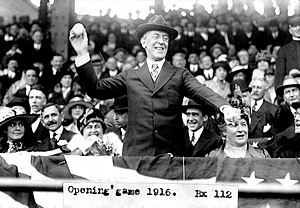
Native Americans played lacrosse before Europeans arrived. Baseball is the country sport for the United States, and American football is the most popular sport. Basketball is also very popular in the USA, which the USA has its own league called the NBA.
Video games
The video game industry of the United States is one of the largest of any country. It is the second largest market for video games after China. Many of the world's largest video game developers are based in the USA, like Take-Two Interactive, Electronic Arts, Activision Blizzard, and Xbox Game Studios.
Measurement
The United States is the only developed country that doesn't officially use the metric system. Instead, the United States customary units are the official measurement system used, though certain fields like science use the metric system. There were also attempts at metrication in the past, most notably in the 1970s, but they have been struck down.
Notes
References
Other websites
 | Definitions from Wiktionary |
 | Media from Commons |
 | News stories from Wikinews |
 | Quotations from Wikiquote |
 | Source texts from Wikisource |
 | Textbooks from Wikibooks |
 | Learning resources from Wikiversity |
 United States travel guide from Wikivoyage
United States travel guide from Wikivoyage
- Government
- Official U.S. Government Web Portal Gateway to governmental sites
- White House Official site of the President of the United States
- Senate Official site of the United States Senate
- House Official site of the United States House of Representatives
- Supreme Court Official site of the Supreme Court of the United States
- Library of Congress Official site of the Library of Congress
- Overviews and data
- Portrait of the United States Overview from the U.S. Information Agency
- United States. Archived 2018-12-25 at the Wayback Machine. CIA World Factbook entry.
- United States Encyclopædia Britannica entry
- U.S. Census Housing and Economic Statistics Wide-ranging data from the U.S. Census Bureau
- State Fact Sheets Population, employment, income, and farm data from the U.S. Economic Research Service
- The 50 States of the U.S.A. Collected informational links for each state
- History
- Historical documents Collected by the National Center for Public Policy Research
- U.S. National Mottos: History and Constitutionality. Archived 2006-12-12 at Archive-It. Analysis by the Ontario Consultants on Religious Tolerance.
- USA Collected links to historical data
- Maps
- Wiki Atlas of the United States
- National Atlas of the United States Official maps from the U.S. Department of the Interior
- Other
- U.S. Citizenship and Immigration Services Official government site
This article uses material from the Wikipedia Simple English article United States, which is released under the Creative Commons Attribution-ShareAlike 3.0 license ("CC BY-SA 3.0"); additional terms may apply (view authors). Content is available under CC BY-SA 4.0 unless otherwise noted. Images, videos and audio are available under their respective licenses.
®Wikipedia is a registered trademark of the Wiki Foundation, Inc. Wiki Simple English (DUHOCTRUNGQUOC.VN) is an independent company and has no affiliation with Wiki Foundation.



